|
|
Post by codystarbuck on Jun 25, 2017 22:33:01 GMT -5
So, they subject of Babylon 5 came up (well, I brought it up, in a Battlestar Galactica thread) and it was suggested we needed a thread. So, why not? I missed on on all but the last few minutes of the pilot broadcast; but, was there at the beginning for the series and stayed to the end. I will admit that I almost quit, part way into the first season. That is, until Mr Morden came to visit the station. That had me hooked, though it was touch and go for a few of the later episodes, with martial arts matches and runaway telepaths. Luckily, I tuned into the season finale and there was no way I wasn't going to be back for the second season.  So, let's start with the pilot,  Episode synopsis: The Babylon Project was a multi-planetary effort to create a diplomatic waypoint in neutral space to prevent future conflicts. It's origin was in the recent Earth-Minbari war, when Earth forces were nearly destroyed by the technologically superior Minbari and who were on the verge of attacking Earth when they suddenly, and without explanation, sued for peace. It was decided to build this station to be a sort of intergalactic United Nations. The designation 5 is due to the destruction of stations 1-3, and the mysterious "disappearance of number 4." The station has become operational and the various ambassadors are arriving on the station. There are also travellers from various points in the galaxy, some looking to conduct trade or to visit, others for more nefarious purposes. Already on the station are Delenn, ambassador from Minbar, the people who had warred with the Earth; Londo Mollari, the ambassador for the Centauri Republic (sort of the Roman Empire, crossed with Renaissance Italy, in space), G'Kar, of the Narn (sort of lizard-like) and several other ambassadors. newly arriving is Kosh, ambassador for the mysterious Vorlon, who have never been seen outside of their "encounter suits." The Earth contingent is represented by CDR. Jeffrey Sinclair, who was part of "The Line," the last defensive formation between the Minbari and Earth, who were fighting to the last man. Something happened to Sinclair, during the battle, and he has no memory of events between launching an attack and waking up back in his ship, with the battle over. His executive officer is LCDR Laurel Takashima, who oversees the bridge, which acts as traffic control for ships entering and leaving the station, as well as the general operations of the station. CWO Michael garibaldi is head of security and he has his hands full, with smugglers and criminals coming through the stations, as well as the usual police headaches from gambling and drinking establishments and other crime. Dr Benjamin Kyle is head of the medical department, providing hospital facilities, as well as medical research. Lyta Alexander is the newly arrived commercial telepath, a member of the Psi Corp. The Psi Corp regulates all telepaths on Earth and the commercial telepaths are hired by parties to aid in negotiations, to help their client determine if their trading partner is acting in good faith. Telepaths cannot scan without consent and must wear gloves to prevent unwarranted contact, which can trigger telepathic connections. Ambassador Kosh's ship enters the station and he is met, but is poisoned. He is rushed to the medical bay as Dr Kyle attempts to stabilize him, without any knowledge of his physiognomy. Lyta Alexander is asked to try to scan his mind for clues and sees an image of CDR Sinclair administering the poison to Kosh. Garibaldi investigates and finds anomalies. He gets on the trail of a human, named Del Varner. He enters Varner's quarters and finds him dead. Varner had been smuggling in alien systems and they discover he had traded a changeling net, which can allow a change in appearance. In sickbay, Lyta enters and starts manipulating the life support for Kosh, when the doctor tries to stop her. The real Lyta enters the room and they realize that this is their assassin. Garibaldi and Sinclair corner the assassin in a maintenance area and disable the changeling net, revealing a Minbari, who utters the phrase, "There is a hole in your mind!" to Sinclair, before triggering an explosive. Kosh is saved and the station opens for business. Sinclair asks Ambassador Delenn about what the Minbari assassin said and she replies, unconvincingly, that it is an old insult. Meanwhile, G'Kar is revealed to have a hand in some dealing, that allowed the assassin to come onboard. Here is the original intro, complete with music by Stewart Copeland, of The Police. There are a lot of differences in the pilot and the series that followed. When the series started, Dr Ben Kyle, LCDR Laurel Takashima, and Lyta Alexander were all replaced by new actors, as new characters, fulfilling the same functions. Their characters were still occasionally referenced in the series and Lyta Alexander would return; first in guest roles, then as a series regular. The look of the series is a bit less detailed than the later series and is shot murkier, to hide the rough edges. There were variances in the make-up, especially the Minbari.  Delenn and the Minbari were presented as androgynous, with a slightly different shape to their cranial bone ridge. Some of the make-up can be seen to be coming loose or loosely fitted, on some of the Minbari. Londo's crest also had a different styling:  and G'Kar's make-up was more angular, around the mouth...  Here are our lost characters, from the human crew:  From left to right: Johnny Sekka as Dr Ben Kyle, Patricia Tallman (showing a nice bit of leg) as Lyta Alexander, and Tamlyn Tomita (Karate Kid 2) as LCDR Laurel Takashima. The series premiered on February 22, 1993, one month after the premiere of Star Trek: Deep Space Nine, which had a similar premise. Joe Straczynski, creator, chief writer, and producer had pitched the series to Paramount who turned it down, before he sold it to Warner Brothers. Many B5 fans have remarked about the similarities in characters and premise, as well as setting. Some went as far to claim that Paramount turned down B5 and then swiped the premise, without paying for it, to create a new Star Trek franchise. No legal action was ever taken and the idea was nothing new in science fiction. B5 would draw inspiration from multiple sources, including Lord of the Rings, historical events (the assassination of JFK and events surrounding WW2), the Lensman Saga, Alfred Bester's The Demolished Man, the Foundation Trilogy and other sci-fi and fantasy influences. The pilot presented some unique scenes, like a trip throup an alien sector, where breathing devices were required, due to different atmospheric mixes. 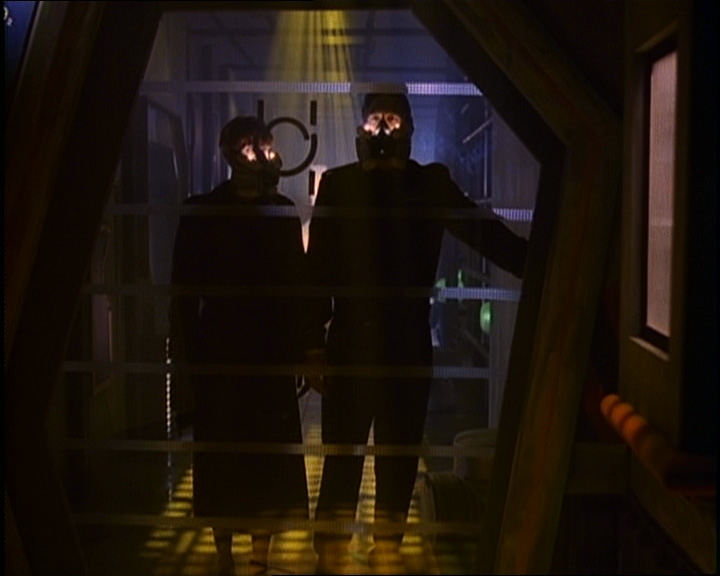 Also, the weapons carried by Earth security, as well as body armor, would later undergo a change. Here, the body armor looks like a cross between a bulletproof vest and a life preserver. The PPGs (Phased Plasma Generator) were a plastic shell, which looked like a toy raygun. The series would replace them with smaller, metal props, which looked more functional. Also of note, when Del Varner meets up with his contact and taps in a door code, a name appears on the ident screen: Takashima, Laurel. Fans uncovered this via freeze frame VCR function and ebated it online, until the season 1 finale, when events occurred in which that character was to be involved. The pilot also introduces a zen garden, where CDR Sinclair likes to meditate, as does Ambassador Delenn. It would make a couple of appearances in the series. The music is very much late 80s, early 90s electronic and less effective than Copeland's music for the Equalizer (which is very much of its time, though it fits the mood better). When the series began, Stewart Copeland was replaced by German composer and former member of Tangerine Dream, Christopher Franke. Franke worked with the Berlin Symphony orchestra to create a more epic and classical soundtrack. many of these scores were later released on CD. The Gathering, in its original form, was broadcast only once. When B5 moved to the TNT network, a new version was broadcast, with re-edits and new music from Franke. This is the version that was released on DVD, along with In The Beginning, a tv movie which details events of the Earth-Minbari War. On the whole, the pilot is an intriguing mystery; but, the story, in original form, has some rough spots The performances of the actors who were replaced were fine and generally on par with most of the others. The standouts are there from the start: Mira Furlon, as Delenn, Peter Jurasik as Londo, and Andreas Katsulas as G'Kar. Michael O'Hare and Jerry Doyle are good, but the three ambassadors are great and would continue to dominate the acting within the series. As such, they also tended to get the best lines. Finally, there were many comparisons with Deep Space 9, given the release time frame and a bit of a flame war between fans of the two franchises. The series do differ in tone and execution, as well as the creative vision behind them. Star Trek has always been a utopian vision of the future, as mankind leaves behind its petty nature (except when that was convenient for an episode plot). babylon 5 took a more realistic view of man's foibles. When man first encounters alien races, he is wary and distrustful, which we will learn helped lead to the Earth-Minbari War. There are still economic divisions, as we see "slums" within the station and there is a hefty criminal element. The alien races are plagued by similar problems. There are political squabbles, economic interests, jealousies, and other failings. It made the series feel more real, to me, though I always enjoyed original Trek and mostly enjoyed Next Gen (though they tended to sit around and debate a heck of a lot more than the Old School Trek). Deep Space 9 didn't really grab me, at the start and I tended not to watch it (a few episodes here and there. Funny enough, once Babylon 5 had established itself, Deep Space 9 would start to embrace the story arc, which B5 used from the onset (inspired somewhat by Blake's 7 and Doctor Who). Also, B5 embraced military protocol and relationships more, which felt like home, to me. They also established a mystery, from the start, while DS9 was more an episode of the week deal, for a while. Here's a scene from The Gathering, which reflects both Sinclair's past, the tone of things, and the mystery... The sad thing is that so many of the cast have departed the world: Richard Biggs (Dr Stephen Franklin), Andreas Katsulas (G'Kar), Jerry Doyle (Michael Garibaldi), Jeff Conway (Zack Allen), Michael O'Hare (CDR Jeffrey Sinclair) and Stephen Furst (Vir Cotto), as well as guest stars Turhan Bey, Majel Barrett, Michael Ansara, Malachi Throne, Theodore Bikel, and others. On the plus side, Barrett and Walter Koenig embraced B5, creating a bridge for Trek fans to try the series. Koenig was actually given a showcase to demonstrate his acting talents, as his Psi Cop, Bester (named for writer Alfred Bester) became a fan favorite and a recurring guest role. So, that was the pilot. Changes would occur, before the series was launched, on January 26, 1994. |
|
|
|
Post by rom on Jun 26, 2017 0:49:00 GMT -5
Great post. As I mentioned in the BG thread, around '94 a girl I knew highly recommended I see the series. However, I was a poor college student at the time and didn't have cable, so had no real way to watch this. Then, after I graduated college in '95, I moved to another state for a new job & left my crappy CRT TV behind. I didn't have a TV for years after that, so completely missed out on this show when it was originally on. My local library has some of the series on DVD, so I will definitely start watching these - I want to watch this in order. It appears the entire series is on DVD - which is great. This thread is also reminding me of the Babylon 5 action figure line(s), which I remember seeing in toy stores back in the late '90's. I never collected any of these since I had 0 familiarity with the show at the time, but am now regretting this. Some of them did indeed look cool, and they're probably very expensive on the secondary market these days: www.figurerealm.com/actionfigure?action=seriesitemlist&id=302It's sad that so many members of the cast have passed at this point. But, it's been almost 20 years since the series ended, so I guess that's to be expected to some extent. |
|
|
|
Post by wildfire2099 on Jun 26, 2017 8:14:56 GMT -5
I'm a big fan of B5... I've never understood why people mock it so much... I've watched it probably 3 or 4 times, and read the PAD books that serve as a nice epilogue. Garabaldi is one of my favorite characters in all of sci-fi.
|
|
|
|
Post by Roquefort Raider on Jun 26, 2017 9:11:29 GMT -5
My first encounter with Babylon 5 was on the net (thanks to that old browser, NCSA Mosaic) in the summer of 1994, back when fan sites were few, far between and filled with text.
The description of the pilot and first few episodes was fascinating. This was no mere TV show with some background material; it was as rich and dense as a proper epic SF novel!
I was particularly enthralled by the hints of properly-managed time travel and the tight continuity between inverted causes and effects. Yes, without a doubt, this would not be a mere shoot 'em up show placed in space nor would it be a Star Trek wannabe; from a distance, it reminded me of Dune in terms of depth. (It's only later that I came across the very apt reference to "Lord of the rings in space").
I eventually started watching the show with reruns of the second season, right before season three started. Great stuff! The entire buildup to the Zha'dum episode was a dream come true for a SF fan.
|
|
|
|
Post by brutalis on Jun 26, 2017 9:58:36 GMT -5
Babylon caught a lot of flack from folks at the time over the "fight" with Deep Space Nine. Lots of people looked down at B5 as wannabe Trek while ignoring the major differences. I was hooked on B5 from the very start and was disappointed that their 5th year went to cable and i was unable to watch. Finally last year the season sets all became affordable and i bought all 5 seasons. I have begun watching the entire series from the beginning and "forcing" myself to wait for that finale.
B5 had splendid actors and stories that are just as compelling and motivating as anything Trek ever did. I love G'Kar and Garibaldi. The interaction between Londo/Vir/G'Kar is superb. Lots of familiar faces both new and old combined with a consistent CGI science fiction look enhancing truly well written stories helped make B5 wonderful television.
You can watch B5 over and over again and still find something new to interest you within it's world. That is really good science fiction and writing at its best. I may not like much of Straczynski's comic book writing but he hit it out of the ballpark with Babylon 5.
|
|
|
|
Post by codystarbuck on Jun 26, 2017 11:01:40 GMT -5
Agreed. Straczynski's writing is tremendous in the series, of which he wrote almost the entire run. The first season has other writers, with JMS handling the majority. The second is even more dominated by JMS, with Peter David penning an episode. 3 and 4 are all JMS and so is 5, apart from one episode by Neil Gaiman. JMS wrote 92 of 110 episodes! If his comic book writing wasn't at the same level, it was probably due to exhaustion!
The series won two Hugo Awards, for the episodes "The Coming of Shadows" and "Severed Dreams," as well as two emmys (visual effects and hair design).
One of the elements I loved was the costuming, in the regular series. They eschewed the utilitarian look of traditional Trek and went more for an extrapolation of everyday wear, functional work clothes, and military uniforms. They presented an interesting color palate that was nice and warm, while also using color cues for alien races. The Minbari religious caste were in very buddhist monk-like robes, while their warriors were in harsh black uniforms. The Centauri were bright, with rich velvets and gold brocade, with the hair crests representing status. The Narn are in harsher, more rugged attire, always looking aggressive. The Earthforce uniforms look like military uniforms, though the short "Ike" jacket meant the actors were constantly pulling them down when they stood up. Later, they get a cool design for the Intergalactic Alliance uniforms. The Rangers look like a combination of warrior monks and Robin Hood's Merry Men.
I also loved the starships and the unique designs for each race. Earth military vessels (the Destroyers) were based on the Leonov, from the movie 2010, with a central rotating arm, while the Minbari resembled seashells, adding to their alien-ness. The Centauri had great sweeping wing structures, matching the curve motif of their hair crests and flag symbols. The Narn ships were harsh and angular, looking like serious warships. The Vorlons were weird and mysterious, like space-going plants/crossed with squids. The Shadows were dark and terrifying, like icky black spiders flying through the stars. The accompanying shrieking sound was unnerving.
My one quibble was with Sheridan and Sinclair's personalities, vs military specialty. Sinclair was a fighter pilot, yet was more thoughtful and reserved, somewhat formal. That is more of the personality of a ship-driver. Sheridan was more brash and cocky, louder, cracked more jokes; that is the personality of a fighter jock. Sheridan was a ship-driver who was the only human to defeat the Minbari in battle. It just seemed like the characters had been put in the wrong fields.
The other brilliant thing was in creating back doors for characters and actors to leave the series and allow other characters to take over their function in the story. Laurel Takashima was to have a major role in the events of the first season finale. When she was replaced for the series, part of her role was shifted to a supporting character, while LCDR Susan Ivanova (Claudia Christian), took over the role of the station Number 2. Ivanova was slated to be brought in after Takashima's character had spent her arc; so, the timetable was just pushed up. Lyta was removed and Andrea Thompson took over as the station telepath. Lyta's contact with Kosh's mind was supposed to alter her and they put together and episode, in season 1, where Talia (Thompson's character) meets an old lover, on the run from the Psi Corps, who unleashes latent abilities in her. However, when she decided to leave the series, Lyta was brought back (first as a cameo, then to take back up her role in relation to the Vorlon).
One thing that really separated B5 from Trek was the interaction with fans and the use of the Internet. JMS was a heavy presence on the Net and communicated directly with fans, answering questions about the series, while also planting seeds to get people to watch. They used to have chats with him and some of the cast that were great fun, especially if Claudia Christian was involved (she was hilarious). By contrast, Paramount had rankled fans with legal threats over some fan sites, before cooler heads prevailed and they worked out guidelines for fans to follow, to protect trademarks. B5 was generally pretty cool, as long as you posted the proper copyright and trademark notices and didn't engage in piracy. There was a heavy tape trading market, which was willfully ignored, so long as it wasn't for-profit. When they did start selling official videos, it was a bit haphazard, rather than series sets. That was one thing I liked about DVD, as studios became more enamored of season sets, rather than pure episode releases, as during the VHS age.
One other person to single out is Harlan Ellison. Ellison had become a friend and mentor to JMS, over the years, and was brought in as a consultant (JMS called him a "free-roaming agent of chaos.") He had two story credits, did a voice role and a cameo role; but, he also had a hand in shaping scripts, developing concepts and characters and provided other advice. He also took part in some marketing featurettes (as long as he was paid) to promote the series after it was launched. he was supposed to write a sequel to his Outer Limits story, "Demon with a Glass Hand;" but, it never came together. JMS had also wanted to do an homage to the Prisoner, with Patrick McGoohan; but, it didn't happen. We had to settle for the Psi Corp salute.
I also loved the fact that they included the gag reels for the seasons, on the DVDs, except for the first season, which I had gotten via a tape trader. Here it is on Youtube. (Some language and NSFW jokes)
|
|
|
|
Post by rom on Jun 26, 2017 18:33:50 GMT -5
Great descriptions, everyone! I haven't even seen one full episode of Babylon 5 yet, and already I feel like I know some of the characters. Very compelling reviews here.
I wonder why the show wasn't more popular?! I guess it was too hardcore sci-fi for some people?! I know that when it was out, it was competing against some of the '90's ST series.
|
|
|
|
Post by codystarbuck on Jun 27, 2017 0:20:11 GMT -5
Great descriptions, everyone! I haven't even seen one full episode of Babylon 5 yet, and already I feel like I know some of the characters. Very compelling reviews here. I wonder why the show wasn't more popular?! I guess it was too hardcore sci-fi for some people?! I know that when it was out, it was competing against some of the '90's ST series. It was never marketed heavily to a mass audience, especially since it was a syndicated show. It also used story arcs, which made it harder to just sample and jump onboard. Trek was episodic, so you could miss an episode and not be lost, much. Miss an episode of B5 and you might find out someone was dead, seceded from their government, fell in love, changed appearance or travelled through time. Warner really dropped the ball. JMS described how Warner operated, as series of semi-autonomous fiefdoms. There was no little or no cross-promotion, which is why he had to go to DC for a comic series, rather than Warner mandate it. Viewership picked up a lot with the move to TNT and DVD sales were good. |
|
|
|
Post by codystarbuck on Jun 27, 2017 1:17:02 GMT -5
Season 1: Signs and Portents Each season of Babylon 5 had a season title, which summed up the theme of that season. Season 1 was Signs and Portents. Throughout the season, we get the comings of different peoples and interests. The pieces are being placed on the gameboard and we well get hints of how the game may turn out. That was one of the beauties of this series, you had to pay attention as even trivial things might turn out to have major consequences. Nothing and no one was exactly what it seemed. Episode 1:  Episode Synopsis-The Centauri colony of Ragesh 3 comes under attack from unknown forces. Meanwhile, licensed commercial telepath Talia Winters arrives on the station, replacing Lyta Alexander. LCDR Susan Ivanova is the new second in command and she seeks out CDR Sinclair, to alert him to the Ragesh 3 problem. We also see a transport ship hit by raiders. Ambassador Mollari is suspicious of the attack on Ragesh 3 and analyzes footage of the attack and identifies a Narn heavy fighter. He confronts G'Kar and has to be restrained by station security. meanwhile, Security Chief Garibaldi investigates a possible link to the raiders and sales of transport info from within B5. Londo Mollari and the Centauri try to bring a motion to the League of Non-Aligned Worlds, to bring sanctions on the Narns, for their part in the attack on the colony. CDR Sinclair is ordered to abstain from the motion by the Earth government. The motion fails and Londo takes matters into his own hands, after seeing a coerced statement made fro Ragesh 3, by a nephew of his. He assembles a secreted weapon and goes to kill G'kar and runs into Talia, who gets a psychic image from him. She alerts Garibaldi who stops Londo. Meanwhile, CDR Sinclair leads a group of the station's Starfury fighters on a patrol to hit the raiders. They use Garibaldi's info and trace the raiders to their next attack and take them out. They then locate a command and control ship, which coordinated the attacks. Sinclair returns to the station and presents a Narn controller, his prisoner, to G'Kar and the council and demands the withdrawl of Narn forces from Ragesh 3 or face further actions for their involvement with piracy of Earth shiping. This was a great opener, filled with character moments and some tremendous battle sequences. B5 immediately said they were different in the battle between the Starfuries and the raider ships. The Starfuries had an X-wing design, with maneuvering thrusters that could move them along three axes. The ships could spin in place, while maintaining motion along an axis and return fire on an attacker. 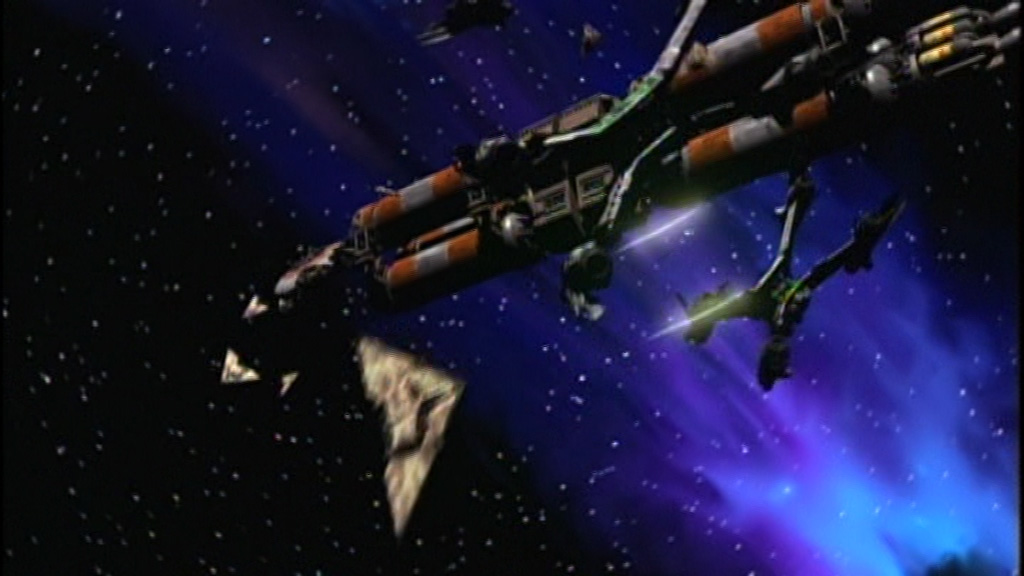 We get a look at how the Ambassadors work together or against each other, via the deliberations of the League of Non-Aligned Worlds. The largest societies are the Earth Alliance, the Centauri Republic, the Narn Regime, the Minbari, and the mysterious Vorlon, though Kosh rarely takes part in deliberations (or gives a straightforward answer to a straightforward question). We meet new characters: 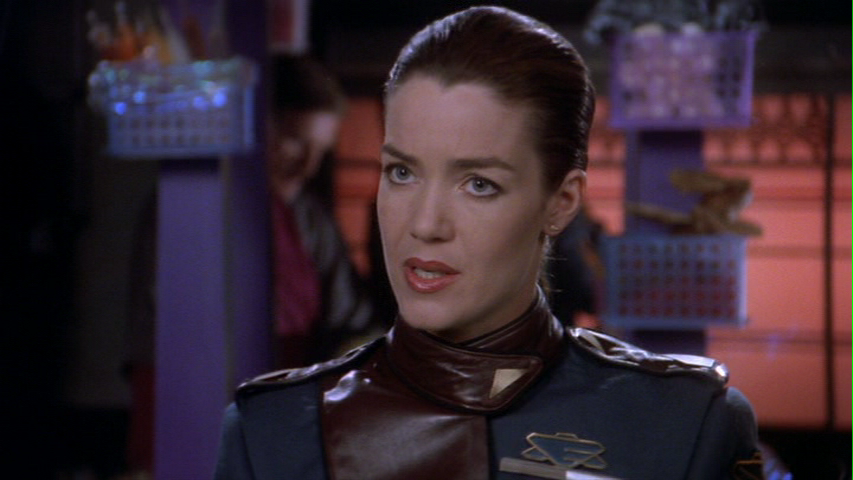 LCDR Susan Ivanova is a Russian and a tough, no-nonsense officer, who scares the hell out of her subordinates. She shows open hostility to Talia Winters, when she arrives and tries to report in. Towards the end of the episode, she apologizes to Talia and explains the basis for her hostility towards the Psi Corp. Her mother was a telepath and refused to join the Corp, according to the law. As such, her alternative was to take medication that suppressed he telepathic abilities. However, they also affected her mental state and the woman she had been slowly faded away, leaving her an empty shell. Ivanova hates the Corps for stealing her mother from her, as she took her own life when she could no longer deal with the drugs. Talia expresses sympathy. Claudia Christian plays Ivanova as tough and sarcastic, though she was allowed to loosen up as the season and series progressed and the writers (aside from JMS) latched onto her sense of humor and ability to deliver a joke. She still had a Russian pessimistic outlook, though, thankfully, they never attempted a Russian accent.  Talia Winters, licensed commercial telepath is new onboard. She grew up in the Psi Corps and entered commercial service, where she acts as a lie detector for clients, in negotiations. Like all telepaths, she wears gloves to prevent unwarranted physical contact with someone and have psychic episodes. This happens when Londo barges into her, as he goes storming off after G'Kar. Talia wears the symbol of the Psi Corps, the Greek letter Psi. Andrea Thompson was cast as Talia, after Patricia Tallman declined to appear in the regular series. Rather than recast, JMS created a new character and slotted Talia into Lyta's former story function. Thompson was a favorite of mine, as she was gorgeous and had a sexy, throaty voice. They also dressed her in very classy, figure-hugging suits, which accentuated her beauty. She would eventually leave the series and work in news broadcasting, including a stint at CNN. At the time of the series, she was married to Jerry Doyle, who played Security Chief Garibaldi. They divorced around the time she left the series.  Vir Cotto is a Centauri and has been assigned as Ambassador Mollari's new aide. Vir is bumbling and shy, lacking in self-confidence. Londo practically eats him alive and treats him poorly, from the start. We will eventually learn that Vir's family had him posted to the position to get rid of him, as he was something of an embarrassment. The position of aide to Londo was actually considered to be a bit of a joke, as the Centauri do not widelt support the mission of Babylon 5 and the League of Non-Aligned Worlds. Over the course of the series, we will see Vir grow stronger and more confident. He is a man of deep conscience and becomes Londo's voice of reason and something of a friend. The late Stephen Furst played Vir wonderfully, showing that he could do comedy and dram, with equal aplomb. In some ways, Vir is Kent Dorfman, Furst's character from Animal House, grown up and out of college, facing a harsh world. Vir's development is one of the pleasures of the series. At his point, G'Kar is depicted as the scheming villain of the series. he was involved in the assassination attempt on Kosh, which hoped to embarrass the Earth Alliance and now he has been show to be involved in arming raiders who are preying on commercial shipping, as well as attacking peaceful remote colonies. Again, no one is exactly who the seem, as we will see a few episodes down the line, as we get new sides to G'Kar.  G'Kar's make-up got a bit of refining, giving him a rounder head and more expressive features, which Andreas Katsulas used to perfection. G'Kar was often called the JR Ewing of B5's first season and it fits.  Ambassador Delenn also got a makeover and the Minbari, as a whole, were changed. Gone is the androgynous look, allowing Mira Furlon's femininity to show through. Originally, the androgyny of the Minbari was to be a story factor, with Delenn undergoing a transformation. The transformation would occur; but, not in the manner originally imagined. The effects had been heavily refined by this point and extensive use of CGI set the series apart. They used virtual sets to create alien environments and to expand physical set. Corridors and sections of B5 would feature practical sets, with CGI used to multiply them and give them distance and volume. a few feet of corridor was turned into yards and even miles. Whatever the faults of the pilot, this series opener really upped the game and set it on a great path. However, we will be spending some time introducing characters and concepts, so subsequent episodes may not have the same oomph. |
|
|
|
Post by brutalis on Jun 27, 2017 8:42:08 GMT -5
That B5 chose for utilizing CGI for all of its effects helped set it apart from Trek and other science fiction series. It allowed them to go for interesting and different sets expansion as well as providing unique ships and space fights. The B5 hallways always helped to set the mood and tone of an episode and that all of the sets were interchangeable and functional for redressing and changes helped keep them from looking too cheap or fake to me.
Costuming was great as well. Rather than trying to go for futuristic styles which might not age well, using the designs and styling of traditional outfits with some tweaks and an eye to color helps make the series have a more timeless feeling. Trek during the same time sometimes comes off as odd or out of place. I do think Trek took note of some of what B5 was doing as you see a definite change in the costuming and the lighting they used from DS9 on. Darker lighting, more somber tones and colors giving a sense of mood and character while moving away from the bright, clean and cheerful utilitarian styles of Next Generation.
|
|
|
|
Post by codystarbuck on Jun 27, 2017 10:08:26 GMT -5
I meant to include this above; the show opening for season 1:
Each season got a new opening, with a new narration (usually by a different character or characters). The narrations usually summed up best what had come before and set the tone for what would come.
|
|
|
|
Post by codystarbuck on Jun 27, 2017 10:30:53 GMT -5
That B5 chose for utilizing CGI for all of its effects helped set it apart from Trek and other science fiction series. It allowed them to go for interesting and different sets expansion as well as providing unique ships and space fights. The B5 hallways always helped to set the mood and tone of an episode and that all of the sets were interchangeable and functional for redressing and changes helped keep them from looking too cheap or fake to me. Costuming was great as well. Rather than trying to go for futuristic styles which might not age well, using the designs and styling of traditional outfits with some tweaks and an eye to color helps make the series have a more timeless feeling. Trek during the same time sometimes comes off as odd or out of place. I do think Trek took note of some of what B5 was doing as you see a definite change in the costuming and the lighting they used from DS9 on. Darker lighting, more somber tones and colors giving a sense of mood and character while moving away from the bright, clean and cheerful utilitarian styles of Next Generation. In many ways, Babylon 5 was superior to Trek: costuming, make-up design, alien environments, innovative designs, use of real science and data from NASA, and the general level of the writing. It wasn't as popular; but, it was a game changer. DS9 soon adopted story arcs and Voyager began using CGI (and DS9 followed). Where B5 really led was in the alien races.  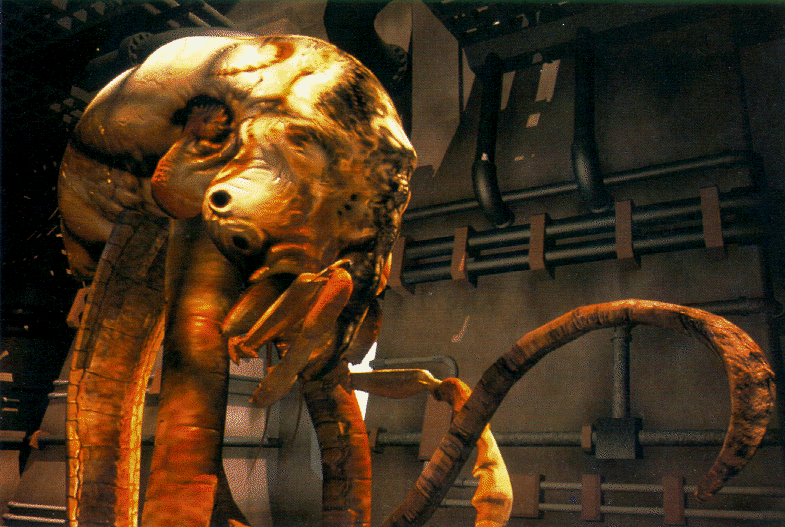  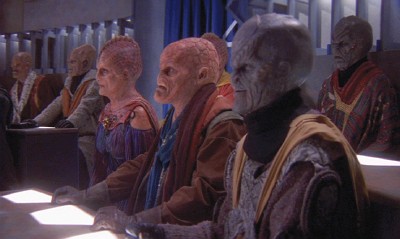 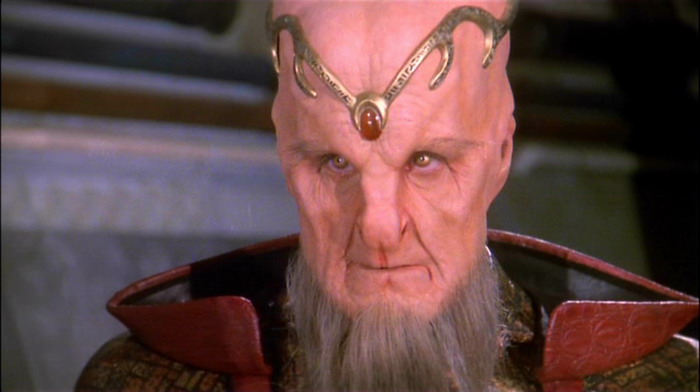  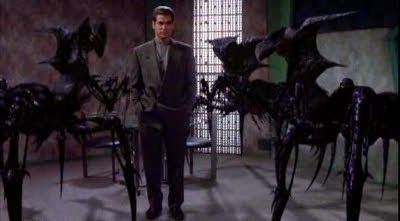   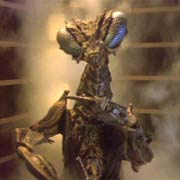 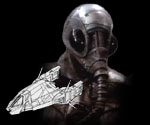 Of the last two, the insectoid creature was a crime boss on B5 and was a mechanical puppet, which didn't quite work as well on screen, so he only appeared in a handful of episodes, in season 1. The latter is called a Gaim, named after Neil Gaiman. The design was inspired by the helmet worn by Morpheus, in Sandman.  |
|
|
|
Post by codystarbuck on Jun 27, 2017 11:31:47 GMT -5
Episode 2:  Guest Star: Morgan Sheppard  Episode synopsis-Dr Stephen Franklin arrives on Babylon 5, replacing Dr Ben Kyle. Franklin is young and spent his youth travelling space on various ships, exchanging medical services for passage. He has an extensive knowledge of alien medicine and anatomy. He is also something of a pacifist, which will factor into later episodes. Meanwhile, a damaged spacecraft appears out of the jumpgate and is on a collision course for B5. CDR Sinclair launches in a Starfury and attempts to capture it with a grapple. He is successful and tows it back to the station. A lone inhabitant appears badly wounded and is rushed to the medlab, where Dr Franklin goes to work. Delenn expresses interest in the alien and his craft. The alien is a Soul Hunter, a race which can sense death and appear to collect the souls of important beings: thinkers, leaders, philosophers, scientists, and similar beings. Delenn tells Sinclair that the Minbari fear Soul Hunters and children are taught to be wary of them. We learn that the Minbari fought to prevent the Soul Hunters from taking the soul of Dukhat (pronounced doo-cot not duck-hat), their leader, who was killed in Minbar's first encounter with Terrans, which sparked the Earth-Minbari War. She later confronts the revived Soul Hunter, wanting to know where his collection is, so she can release Minbari souls. The Soul Hunter later escapes, incapacitating a guard and taking his weapon. Meanwhile, another Soul Hunter arrives and demands to speak to CDR Sinclair. He tells him that the first Soul Hunter is unstable and was never able to get over the failure of collecting Dukhat's soul. He began taking life to speed up the collection process, in violation of their customs. It turns out that he has captured Delenn and intends to bleed her to death, then capture her soul in his machine. Sinclair locates the chamber where he is holding Delenn and is able to rescue her by turning the machine on the Soul Hunter. As he is dying, the Soul Hunter tells Sinclair, "They are using you!" The weakened Delenn says to Sinclair, "We were right about you." Sinclair is puzzled, as we get a snippet of the mystery of his relationship to the Minbari. The episode ends with Delenn, in her chamber, holding the orbs which contain souls. One by one she releases them and we see the glowing energy spread out into space. This episode felt very "Star Trek," as it was more of a stand-alone story, with a lot of exposition and character development. Things are resolved by the end and the status quo is reinstated. However, seeds are planted about the mystery of why the Minbari insisted in Sinclair's naming as commander of Babylon 5 (which the Minbari co-financed) and how it might relate to the missing hours from the Battle of the Line. How are the Minbari using Sinclair? What did Delen mean by, "We were right about you?" However, on the face of the episode, these seem like background details and we don't really expect to see much from this. We will later learn that there are several plot points related to this episode, showing how intricate JMS's series arc was. The entire 5 years had been planned out from the first and episodes had significance within that 5 year plan. The first season has the least arc-centric episodes; but, many points raised in even the lesser episodes factored into later events. In the pilot, we saw G'Kar try to barter with Lyta to obtain telepath DNA, as the Narn's are the only major race without telepaths, their own having been wiped out. This will factor into another first season episode and moreso in later seasons, as we learn the greater importance of telepaths. 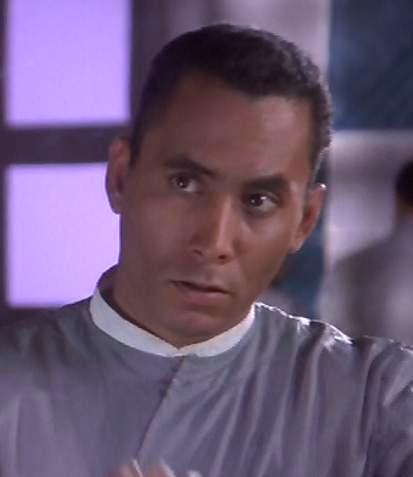 Richard Biggs was listed in the opening cast credits in episode one; but, he makes his debut, here. He was a theater major at USC and briefly taught high school, before landing acting jobs. He appeared on the soap opera Days of Our Lives, before being cast in B5. He was born deaf in one ear and partially deaf in the other. In his adult life, after becoming known for B5, he made many fundraising appearances in support of the Aliso Academy, a school for deaf children. Franklin was one of the moral centers of the show, as Stephen argued for the preservation of life and for the strength of diversity of lifeforms. We later learn that he refused to cooperate with his own government, during the Earth-Minbari War, who demanded his knowledge of Minbari anatomy, gained during an encounter with a dying member of the race. He refused to let medical knowledge be used for military purposes. In later seasons, he will battle an addiction to stimulants, which he began taking due to the pressure of the demand for medical services, during the early stages of the Shadow War. The character also has a wicked sense of humor and often jousts with Garibaldi and Ivanova. In season 4, he is sent on a mission to link up with the Mars Resistance and is paired with Marcus Cole, a human Ranger, played by British actor Jason Carter. The pair had great comic chemistry and they travel under the cover story of being a couple, which Marcus plays to the hilt, to Franklin's consternation. Tragically Richard Biggs was one of the first losses of the B5 cast. He collapsed in his home and died of complications from arterial disease, at the age of 44. Delenn is also featured heavily in this episode and Mira Furlan always played her with tremendous depth. She had long speeches and she delivers them with sensitivity and gusto. She often had problems with technical details and nuances of language, as English was not her first language. Furlan is Croatian and was born in Yugoslavia. She became one of the leading actresses both on the Yugoslav stage and in film, winning many awards. When the Yugoslavian Federation broke apart and Serbia invaded Bosnia, Furlan refused to use her celebrity status as a propaganda tool for any faction. She was part of an artistic community that called for peace and for people to live in harmony. This stance, coupled with a marriage to Serbian director Goran Gajic led to death threats and she and her husband fled the country, first emigrating to the UK and then the United States. Because of her accent, she found it hard to gain roles, until Babylon 5. She would later appear in Lost. She tells a story of an early sci-fi convention, where she spoke of leaving Yugoslavia and losing her home and family. A fan stood up and sai "Welcome to your new family!" which greatly touched her. However, she was puzzled by a request at another appearance, where some asked her to say "Moose and squirrel," which she did, to riotous laughter. She had to be clued in to Rocky & Bullwinkle by cast members to understand the joke. Delenn has a great scene at te end, when she releases the souls of the Minbari... 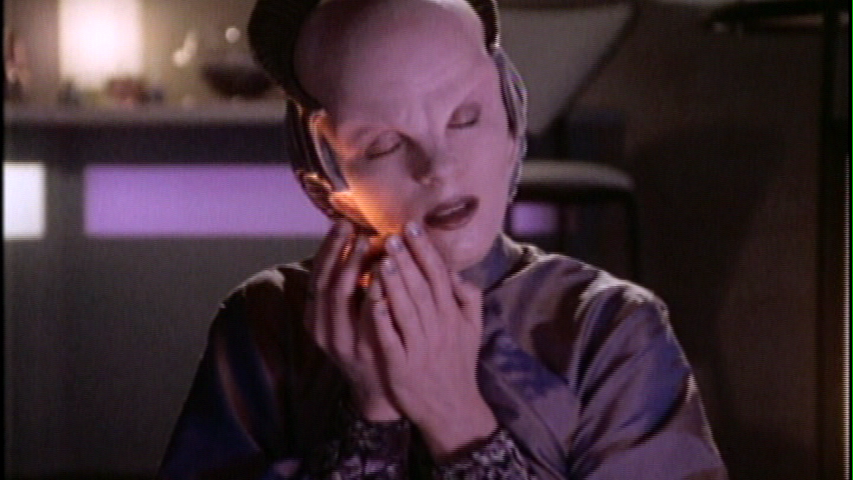 Furlan really sells the moment entirely through physical acting, never saying a word. She lovingly caresses the orbs then releases them to join with the stars, in conjunction with the Minbari belief that all life comes from the stars and rejoins with it, upon death, to be reborn in a new form. This will factor into later events. We also learn that she is a "Satai," one of the ruling body of the Minbari. The Soul Hunter utters this to Sinclair, who researches the word and discovers its meaning. He is puzzled as to why a member of the ruling council would be an ambassador to Babylon 5. In the pilot, Delenn, angered by G'Kar during a visit to her chambers, uses a ring that magnifies gravity on him, to show him his threats are hollow. The device is never reused, though we do see almost mystical elements with the Minbari, at several stages. The Minbari will also factor heavily into the early issues of the DC comic, which I will try to cover, alongside the series (as well as a bit about the novels). All in all, this felt like a bit of a letdown from the pilot, in terms of action, though it is a strong character episode. It hints at why B5 may not have connected with some viewers, who may have tuned into the premiere. The first episode was filled with action and intrigue, while this felt more like an average Trek story, heavy on philosophy. At the time, I was greatly disappointed by it and hoped we would see better episodes. I came to appreciate it more when I saw how it fit into later events. Still, the Soul Hunters are not favorites and when one of the TNT movies ("A River of Souls) was built around a Soul Hunter (played by Martin Sheen), I was less than impressed. Actually, I was disappointed in many of the TNT movies, apart from "In the Beginning," which details events of the Earth-Minbari War, giving us the full scope, and "A Call to Arms," which served as a pilot for the sequel series, Crusade. Unfortunately, Crusade was crippled by political problems between JMS and Warner Brothers and died a quick death. Before I forget, Morgan Sheppard was a favorite actor. he had a gravelly voice that he used well, often playing gruff, but likeable characters. He played Blank Reg, in the cult favorite Max Headroom tv series, was the warden of the Gulag in Star Trek 6, appeared as a fencing master in Ridley Scott's The Duellists, played a boxing manager in the Tom Selleck movie Lassiter, appeared in Cry Freedom, The Elephant Man, Gods and Generals, and the Prestige. He studied at Royal Academy of Dramatic Art and was part of the Royal Shakespeare Company. Tremendous actor, who brought gusto to parts large and small, even in junk like Hawk the Slayer. His son Mark Sheppard played the lawyer, Romo Lampkin, in the revived Battlestar Galactica, as well as Badger, on Joss Whedon's Firefly and as an FBI official on Dollhouse. Morgan Sheppard would return in season 2 as the Narn military commander, G'Sten, a relative of G'Kar. |
|
|
|
Post by codystarbuck on Jun 27, 2017 14:53:09 GMT -5
Episode 3:  Guest Stars-Clive Revill as Trakis, Fabiana Udenio as Adira Negotiations are underway for the Euphrates Treaty, involving the Narn and the Centauri; but, Londo is nowhere to be found,. Sinclair and G'Kar track him down to a strip club (another thing you didn't get much of, on Trek) and tell him they are waiting. They see Londo admiring a Centauri woman, one of the dancers. Later we see her waiting in his bed, as they are having an affair. Meanwhile, Garibaldi has uncovered unauthorized use of the Gold Channel, a communications channel reserved for command staff and diplomats. The messages terminate somewhere in the Russian Consortium, a subsection of the Earth Alliance. GaribaLdi alerts LCDR Ivanova, who seems less alarmed about the situation than Garibaldi. She says she will look into it, when she has time and tells Garibaldi to continue monitoring the channel. Londo is in bed with the Centauri dancer, Adira Tyree, when Vir comes in to tell him he is over an hour later for negotiations. Londo tells him to convey he will be there soon. When he departs Adira, she returns to her own quarters, where we see Trakis, her owner. Adira is a slave and has been tasked with stealing the Purple files, sensitive information about Londo and the Centauri government. He plans to sell them and admonishes her to get them. Londo later arrives at her quarters with a gift of flowers and a broach, which is an heirloom of House Mollari. She tries to refuse it, but he insists. he takes her to Fresh Air, a high-end restaurant on the station. Sinclair takes Talia Winters there as a reward for helping with the negotiations. Se remarks that Londo's thoughts were very erotic and Sinclair points her to the couple of Londo and Adira. returning to Londo's quarters, Adira slips hima mickey and uses a mind probe to steal the Purple Files. She goes to meet Trakis, but flees when she sees him. Vir finds Londo, who is again late for negotiations and he tells Vir he has full authority to carry on the negotiations, while Londo goes off to search for Adira. Vir goes off on his assignment and G'Kar is angered by the affront and turns things over to his new aide, Ko D'Ath. Trakis finds Londo in Adira's quarter and tells him the truth about her, while planting a bug on Londo. Londo goes off to find Adira, while Trakis monitors Londo and hires some thugs from alien crime boss N'Grath (the insect guy pictured in a post above). Londo runs into Sinclair and secures his help to find Adira. They go undercover and run into Trakis' thugs. They get into a firefight, which Ivanova detects and alerts Garibaldi. he sends a team to investigate, while he continues monitoring the Gold Channel. he discovers that Ivanova has been the one using it, to monitor the status of her father, who has been in a coma. He awakens and speaks to her, via the link, and apologizes for not having been a more loving father. He then slowly dies, as Ivanova watches and cries. Trakis has secured Adira and Sinclair enlists Talia's help, then alerts G'Kar that the Purple Files have been stolen. G'Kar meets with Trakis to buy them and Talia is able to pull out of his mind where Adira is being held. Londo decks him and takes back the Purple Files and thanks G'Kar for helping save the Centauri Republic. G'Kar storms off in disgust. Adira leaves the station a free woman and Londo again gives her the family broach (which she had returned) and tells her to wear it proudly as a free woman. Garibaldi meets with Ivanova and tells her that the access was a computer error and asks her if it will happen again. He offers to buy her a drink and she tells him she may take him up on it later. Great episode, which gets into the character of Londo, who is seen as a romantic patriot. He falls deeply for Adira, despite her low status in his culture. She asks how he can be seen with her and he says status isn't as important as love. Adira has feelings for Londo and his pure love causes her to rebel against her master, putting her in jeopardy to protect Londo. Sinclair finds himself amused and pleased by Londo's interest in Adira, despite the problems it causes with negotiations. Talia gets to do a bit of work and also gets to integrate more with the other cast. Ivanova gets to drop her hard facade and gets a very emotional scene with her dying father. This leads to the scene with Garibaldi, at the end, which adds a bonding moment for them. The episode introduces Ko D'Ath, G'Kar's new aide, played by Mary Woronov (of various Roger Corman films, including Death Race 2000 and Rock n Roll High School and Andy Warhol projects). This was Woronov's only appearance, as she found the make-up process to arduous and unsettling. She was actually a replacement for actress Susan Kellerman, who went into a complete mental breakdown when she saw herself in a mirror in the make-up. Bill Mumy describes it here (though he was not in this episode). Two episodes later, G'Kar gets a new aide, Na'Toth, played by Julie Caitlin Brown. He explains that his previous aid had an accident with an airlock. There is a lot of great lines in this one, as when Vir enters Londo's quarters and he says "What do you want, you moon-faced assassin of joy?" When he tells Vir he is authorized to act in the negotiations, he tells him not to "...give away the homeworld." Later, when G'Kar storms out at the insult, he tells Ko D'Ath to take over and not to "...give away the homeworld." Also, Ko D'Ath first enters the scene and finds G'Kar in the struip club, to his embarrassment and he is forced to leave to show her to her quarters, despite enjoying the show. 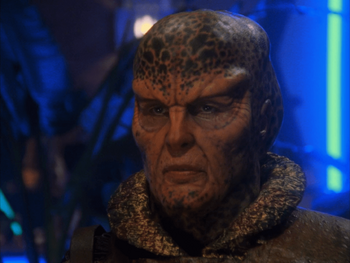 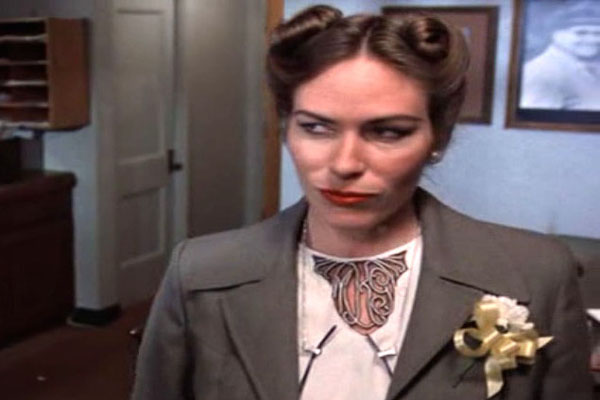  Mary Woronov as Ko D'Ath. It's a shame she didn't continue, as she had a nice chemistry with Andreas Katsulas. Julie Caitlin Brown also had a good rapport, but declined to come back as Na'Toth for the second season, as she didn't like the process and thought it would limit her film career. She did later return as the character for one episode, as well as a new human character, for a guest spot. 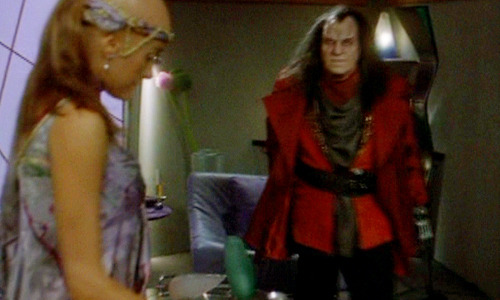  Trakis is played by Clive Revill, the New Zealand-born actor who portrayed the Emperor. originally, in Empire Strikes Back. He was notable for his stage work in Shakespeare and in the West End and Broadway, including a Tony nomination for playing Fagin, in Oliver! He was notable in the 60s for comedic turns in such camp and farcical films as Modesty Blaise, Fathom, and The Assassination Bureau. He also starred in the horror film The Legend of Hell House.   Fabian Udenio is an Argentinian actress, notable for the role of Alotta Fagina, in the first Austin Powers movie, as well as Robocop 2 and Bride of the Re-Animator and The Wedding Planner. This is the first time we see a Centauri woman; and, in contrast to the men, they shave their heads bald. It also shows their subservient position to Centauri males. By contrast, Ko D'Ath is an intimidating figure to G'Kar, as does, later, Na'Toth. Londo is already married, though we will have to wait for the second season to meet his three (!!!) wives. We again see N'Grath; but, the character is used sparingly and will soon disappear, quietly. I can't recall exactly; but, I think he is referred to as having been rubbed out by a rival. Again, this is more episodic, as everything is resolved by the end and it focuses mostly on character development. In that it is, again, very much like Trek. However, it also gets into cultural elements that will reoccur, and Londo's love of Adira will also factor into that character's arc and decisions he makes and their consequences. One of the recurring themes is the consequences of decisions, as one seeming little choice may have major repercussions later. |
|
|
|
Post by String on Jun 27, 2017 15:20:09 GMT -5
B5 was a great series, one that stood up on it's own merits and frankly, didn't deserve the comparisons and ridicule from DS9. If you were a loyal watcher, the show gave you innumerable pay-offs as you became drawn into the lives of these varied characters and races. It dealt with mature themes and difficult issues and it's probably the one thing that would ever make me despise Walter Koenig.
I also love the fact that the tie-in novels and comics were as closely controlled as the episodes and ALL are considered canon.
|
|










































